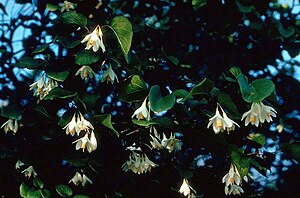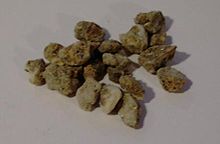Storax trees
| Storax trees | ||||||||||||
|---|---|---|---|---|---|---|---|---|---|---|---|---|

|
||||||||||||
| Systematics | ||||||||||||
|
||||||||||||
| Scientific name | ||||||||||||
| Styrax | ||||||||||||
| L. |
The Storax trees ( Styrax ) are a genus of plants that contains 120 to 150 species and is therefore the most species-rich genus of the Storax tree family (Styracaceae).
description

Vegetative characteristics
In styrax TYPES it concerns both deciduous and evergreen small trees , sometimes shrubs , the stature heights of 2 reach 20 meters. The deciduous species often have large leaves that are up to 20 centimeters long in some species. The simple, mostly alternate leaves are hairy or rarely glabrous. There are no stipules.
Generative characteristics
The inflorescences can be racemose or paniculate or zymose , rarely the flowers are in clusters or individually. The hermaphroditic, radial symmetry flowers are often five-fold. Their pure white, sometimes a little reddish, petals lean slightly together so that the flowers are slightly bell-shaped. There are usually ten (8 to 13) stamens with yellowish anthers . The ovary is on top.
The fruits are stone fruits , the mesocarp of which can be both fleshy and leathery-dry. The fruits usually only contain one seed. There are species with winged seeds, most species have ribbed seeds, and some species have smooth seeds.
distribution
The Styrax species occur in all areas of the family: Most species come from East Asia , many also from tropical South America or Mexico . One species, the Storax tree ( Styrax officinalis ), is also found in Asia Minor , in the eastern Mediterranean , and with another subspecies in California . Individual locations are also known from Italy .






Systematics
The genus Styrax was established in 1753 by Carl von Linné in Species Plantarum 1, p. 444.
There are 120 to 150 species in the genus Styrax . Here is a list of species (selection):
- Styrax americanus Lam. : It occurs in the United States.
- Styrax argenteus C. Presl : It was described from Mexico.
- Styrax benzoides Craib : It occurs in Thailand, Laos, Vietnam and Yunnan.
- Benzoin tree ( Styrax benzoin Dryand. ): It is found in India, Indonesia, Malaysia, Thailand, Laos, Cambodia, Vietnam and Myanmar.
- Styrax calvescens Perkins : It occurs in China.
- Styrax camporum Pohl : It was described from Brazil.
- Styrax confusus Hemsl. (Syn .: Styrax philadelphoides Perkins ): It occurs in China.
- Styrax dasyanthus Perkins : It occurs in China.
- Styrax faberi Perkins : It occurs in China and Taiwan.
- Styrax formosanus Matsum. : It occurs in China and Taiwan.
- Styrax grandifolius Aiton : It occurs in the United States.
- Styrax hemsleyanus Diels : It occurs in China.
- Styrax hookeri C.B.Clarke (Syn .: Styrax perkinsiae Rehder , Styrax shweliensis W.W.Sm. )
-
Japanese storax tree ( Styrax japonicus Siebold & Zucc. , Syn .: Styrax bodinieri H.Lév. , Styrax seminatus Farges ): It occurs in the Philippines, Laos, Vietnam, Japan, Korea, Taiwan and China. With the variety:
- Styrax japonicus var. Kotoensis (Hayata) Matsum. & Suzuki (Syn .: Styrax grandiflorus Griff. , Styrax kotoensis Hayata ): It occurs in the Philippines, China, Japan and Taiwan.
- Styrax limprichtii Lingelsh. & Borza (Syn .: Styrax langkongensis W.W.Sm. ): It occurs in Sichuan and Yunnan.
- Styrax maninul B.Walln. : It was described from Brazil.
- Obassia-Storaxbaum ( Styrax obassia Sieb. & Zucc. )
- Styrax odoratissimus Champ. ex Benth. (Syn .: Styrax veitchiorum Hemsl. & EHWilson ): It occurs in China.
- Storax tree ( Styrax officinalis L. )
- Styrax paralleloneurus Perkins : It occurs in Indonesia, Malaysia and Thailand.
- Styrax platanifolius Engelm. : It occurs in four subspecies in Texas and Mexico.
- Styrax portoricensis Jug & Urb. : It occurs in Puerto Rico .
- Styrax redivivus (Torr.) LCWheeler (Syn .: Darlingtonia rediviva Torr. , Styrax californicus Torr. , Styrax officinalis var. Californicus (Torr.) Rehder ): It occurs in California.
- Styrax serrulatus Roxb. : It occurs in India, Nepal, Thailand, Malaysia, Laos, Vietnam, Myanmar, Taiwan and in China.
- Styrax shiraianus Makino : It occurs in Japan.
- Styrax suberifolius Hook. & Arn. : It occurs in China and Taiwan.
- Styrax texanus Cory : It occurs in Texas. Some authors also call it the subspecies Styrax platanifolius Engelm. ex Torr. subsp. texanus (Cory) PW Fritsch added to Styrax platanifolius .
- Siam Benzoin tree ( Styrax tonkinensis (Pierre) Craib ex Hartwich , Syn .: Styrax hypoglaucus Perkins ): It occurs in Thailand, Laos, Cambodia, Vietnam and China.
- Styrax wilsonii Rehder : It occurs in Sichuan.
- Styrax wuyuanensis S.M. Hwang : It was described from China.
- Styrax youngiae Cory : It occurs in Texas and Mexico. Some authors also call it the subspecies Styrax platanifolius Engelm. ex Torr. subsp. youngiae (Cory) PW Fritsch posedto Styrax platanifolius .
- Styrax zhejiangensis S.M. Hwang & LLYu : This endemic thrives in the thicket along the banks of rivers at altitudes of around 900 meters only in Jiande Xian in the Chinese province of Zhejiang.
The following species are now assigned to other genera:
- Styrax biaristatus W.W.Sm. → Huodendron biaristatum (WWSm.) Rehder
use
Some of the species have fragrant resins obtained by scratching the bark, benzoin . The most important of these are the benzoin tree ( Styrax benzoin ) and the Siam benzoin tree ( Styrax tonkinensis ), as well as Styrax paralleloneurus , the storax tree , which occurs almost in the entire area of the genus, and whose alleged resin is then also referred to as styrax or storax resin, is controversial . Others are the Sumatran species Styrax ridleyanus and Styrax subpaniculatus , as well as Styrax serrulatus from India and Malaysia and the neotropical species Styrax camporum and Styrax ferrugineus , Styrax argenteus and Styrax warscewiczii , Styrax tessmannii , Styrax pear .
The benzoin and styrax resin is used as an incense, in the cosmetics and perfume industries and for benzoic acid production , and as a medicinal tincture .
Some deciduous species, for example the Japanese storax tree , the obassia storax tree and again the storax tree , are also popular in gardens and parks because of their pretty flowers and leaves and because they are not too big.
literature
- PW Fritsch: Phylogeny and biogeography of the flowering plant genus Styrax (Styracaceae) based on chloroplast DNA restriction sites and DNA sequences of the internal transcribed spacer region. In: Molecular Phylogenetics and Evolution , Volume 19, 2001, pp. 387-408.
- Shumei Huang, James W. Grimes: Styracaceae. : Styrax , p. 253 - online with the same text as the printed work , In: Wu Zheng-yi, Peter H. Raven (Ed.): Flora of China. Volume 15: Myrsinaceae through Loganiaceae , Science Press and Missouri Botanical Garden Press, Beijing and St. Louis, 1996, ISBN 0-915279-37-1 .
Web links
Individual evidence
- ↑ a b c d e f g h i j k l m n o p q r s t u v w x y Styrax in the Germplasm Resources Information Network (GRIN), USDA , ARS , National Genetic Resources Program. National Germplasm Resources Laboratory, Beltsville, Maryland. Retrieved October 7, 2017.
- ↑ http://www.efloras.org/florataxon.aspx?flora_id=2&taxon_id=200017764 : "Damp and shady areas or in forest thickets; approx. 2000 m. S Anhui, NE Jiangxi"
- ↑ Shumei Huang, James W. Grimes: Styracaceae. : Styrax , p. 253 - online with the same text as the printed work , In: Wu Zheng-yi, Peter H. Raven (Ed.): Flora of China. Volume 15: Myrsinaceae through Loganiaceae , Science Press and Missouri Botanical Garden Press, Beijing and St. Louis, 1996, ISBN 0-915279-37-1 .
- ^ Jean H. Langenheim: Plant Resins. Timber Press, 2003, ISBN 978-0-88192-574-6 , pp. 347-356. online (PDF; 22.18 MB).
